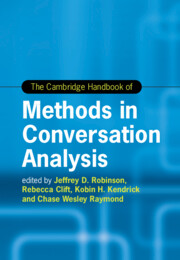Book contents
- Frontmatter
- Contents
- List of Tables
- List of Contributors
- Part I Introduction
- Part II Points of Departure
- Part III Collections
- Part IV Evidence
- Part V Avenues into Action
- 18 Single-Case Analysis
- 19 Ethnomethodology, Conversation Analysis, and the Study of Interaction in Everyday Life
- 20 Analyzing Categorial Phenomena in Talk-in-Interaction
- 21 Where the Action Is: Positioning Matters in Interaction
- 22 Analyzing Particles
- 23 Analyzing Grammar in Social Interaction
- 24 Listening to Talk-in-Interaction: Ways of Observing Speech
- 25 Multimodality in Conversation Analysis
- 26 System-Oriented Analysis: Moving from Singular Practices to Organizations of Practice
- 27 Comparing across Languages and Cultures
- 28 Methodological Considerations When Using Conversation Analysis to Investigate Institutional Interaction
- 29 Methods for ‘Applying’ Conversation Analysis
- 30 Using Conversation-Analytic Research Methods in the Study of Atypical Populations
- Part VI Situating and Reporting Findings
- Part VII Looking Forward
- Appendix I Jeffersonian Transcription Conventions
- Appendix II Multimodal Transcription Conventions
- Index
22 - Analyzing Particles
from Part V - Avenues into Action
Published online by Cambridge University Press: 06 December 2024
- Frontmatter
- Contents
- List of Tables
- List of Contributors
- Part I Introduction
- Part II Points of Departure
- Part III Collections
- Part IV Evidence
- Part V Avenues into Action
- 18 Single-Case Analysis
- 19 Ethnomethodology, Conversation Analysis, and the Study of Interaction in Everyday Life
- 20 Analyzing Categorial Phenomena in Talk-in-Interaction
- 21 Where the Action Is: Positioning Matters in Interaction
- 22 Analyzing Particles
- 23 Analyzing Grammar in Social Interaction
- 24 Listening to Talk-in-Interaction: Ways of Observing Speech
- 25 Multimodality in Conversation Analysis
- 26 System-Oriented Analysis: Moving from Singular Practices to Organizations of Practice
- 27 Comparing across Languages and Cultures
- 28 Methodological Considerations When Using Conversation Analysis to Investigate Institutional Interaction
- 29 Methods for ‘Applying’ Conversation Analysis
- 30 Using Conversation-Analytic Research Methods in the Study of Atypical Populations
- Part VI Situating and Reporting Findings
- Part VII Looking Forward
- Appendix I Jeffersonian Transcription Conventions
- Appendix II Multimodal Transcription Conventions
- Index
Summary
This chapter discusses best practices for conducting a conversation-analytic (CA) investigation into (discourse) particles (or discourse markers). Particles are ubiquitous in talk-in-interaction, making them an attractive research target. CA research into particles aims to elucidate their interactional deployment in the language under study and, more generally, to develop a deeper understanding of the infrastructure of social interaction. The chapter discusses conceptual underpinnings of the CA approach to analyzing particles: first, its orientation to social action; second, its emphasis on positionality (including the particle’s position in a turn, a sequence, a repair segment, and a conversation as a unit); and, third, its use of particular evidentiary procedures (such as the ‘next-turn proof procedure,’ positional deployment, distributional evidence, and deviant cases). The application of these principles is illustrated with two case studies: a semasiological study of the Russian particle nu and an onomasiological study of how courses of action are launched via so and oh prefaced turns. The chapter shows that, while fraught with challenges, a study of particles can lead to important and unexpected findings about social interaction.
Information
- Type
- Chapter
- Information
- The Cambridge Handbook of Methods in Conversation Analysis , pp. 611 - 640Publisher: Cambridge University PressPrint publication year: 2024
Accessibility standard: Unknown
Why this information is here
This section outlines the accessibility features of this content - including support for screen readers, full keyboard navigation and high-contrast display options. This may not be relevant for you.Accessibility Information
- 1
- Cited by
